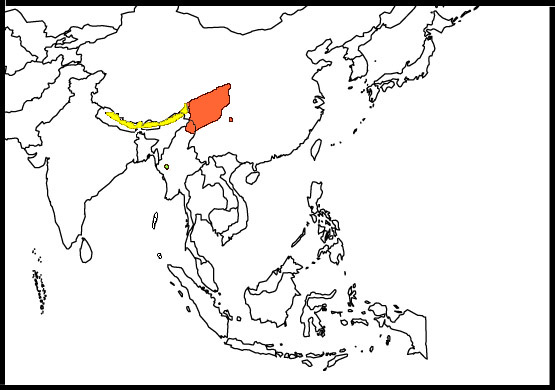| Line 1: | Line 1: | ||
| + | '''Alternative names: Rufous-fronted Bushtit; Black-browed Bushtit; Rufous-fronted Tit; Blyth's Tit; Pere Bonvalot's Tit; Black-headed Tit; Himalayan Tit; Blyth's Long-tailed Tit; Himalayan Tit''' | ||
[[Image:Black-browed_Tit.jpg|thumb|550px|right|Photo by {{user|Rajiv+Lather|Rajiv Lather}}<br>Location: [[Bhutan]]<br />''A.i. iouschistos'']] | [[Image:Black-browed_Tit.jpg|thumb|550px|right|Photo by {{user|Rajiv+Lather|Rajiv Lather}}<br>Location: [[Bhutan]]<br />''A.i. iouschistos'']] | ||
| − | |||
;[[:Category:Aegithalos|Aegithalos]] iouschistos | ;[[:Category:Aegithalos|Aegithalos]] iouschistos | ||
'''Includes Black-browed Tit and Burmese Tit''' | '''Includes Black-browed Tit and Burmese Tit''' | ||
| Line 42: | Line 42: | ||
Boreal forests and temperate forests, especially rhododendron zone and low scrubby deciduous trees. | Boreal forests and temperate forests, especially rhododendron zone and low scrubby deciduous trees. | ||
==Behaviour== | ==Behaviour== | ||
| + | Feeds on insects, larvae, sometimes on vegetable matter.<br /> | ||
| + | Breeds from April to July. The nest is a ball made of lichens and lined with feathers. <br /> | ||
| + | Outside the breeding season found in flocks of 10 to 40 birds, foraging through all heights of forest.<br /> | ||
| + | Resident with some altitudinal movement in winter. | ||
| + | ==References== | ||
| + | # {{Ref-HBWVol13}} | ||
| + | # {{Ref-RasmussenAnderton05}} | ||
==External Links== | ==External Links== | ||
{{GSearch|Aegithalos+iouschistos}} | {{GSearch|Aegithalos+iouschistos}} | ||
[[Category:Birds]] [[Category:Aegithalos]] | [[Category:Birds]] [[Category:Aegithalos]] | ||
Revision as of 16:26, 21 March 2009
Alternative names: Rufous-fronted Bushtit; Black-browed Bushtit; Rufous-fronted Tit; Blyth's Tit; Pere Bonvalot's Tit; Black-headed Tit; Himalayan Tit; Blyth's Long-tailed Tit; Himalayan Tit
- Aegithalos iouschistos
Includes Black-browed Tit and Burmese Tit
Identification
11cm.
Iouschistos:
- Tiny, fulvous tit
- Buffy cheek and silvery throat-patch
- Broad black mask
- Broad buff coronal stripe
Bonvaloti:
- White coronal stripe, palar, upper breast and vent
- Smoky-grey chin
- Paler sides and white belly
Sharpei:
- Pattern very like White-throated Tit
- Buffy underparts
- More white on throat and head than bonvaloti
Juveniles are much paler but already have the broad crown-stripes.
Distribution
| Found from central Nepal east in a small band in the Himalayas to Bhutan and northeast India. In China in Sichuan and adjacent regions. Locally also in Burma (Mount Victoria and at northern boundary to China). | |
| Legend • A. iouschistos; year-round |
Taxonomy
Four subspecies accepted which are sometimes split in up to three species:
- A. i. iouschistos
- A. i. bonvaloti and A. i. obscuratus (Black-browed Tit)
- A. sharpei from Mount Victoria (Burmese Tit)
The three forms seem to be morphologically distinct and form a superspecies with White-throated Tit. No evidence of intergradiation or hybridization where ranges meet.
Habitat
Boreal forests and temperate forests, especially rhododendron zone and low scrubby deciduous trees.
Behaviour
Feeds on insects, larvae, sometimes on vegetable matter.
Breeds from April to July. The nest is a ball made of lichens and lined with feathers.
Outside the breeding season found in flocks of 10 to 40 birds, foraging through all heights of forest.
Resident with some altitudinal movement in winter.
References
- Del Hoyo, J, A Elliott, and D Christie, eds. 2008. Handbook of the Birds of the World. Volume 13: Penduline-tits to Shrikes. Barcelona: Lynx Edicions. ISBN 978-8496553453
- Rasmussen, PC and JC Anderton. 2005. Birds of South Asia: The Ripley Guide. Barcelona: Lynx Edicions. ISBN 978-8487334672





